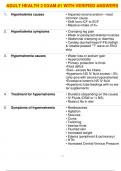ADULT HEALTH 2 EXAM #1 WITH VERIFIED ANSWERS
1. Hyperkalemia causes • Impaired renal excretion—most
common cause
• Shift from ICF to ECF
• Massive intake of K+
2. Hyperkalemia symptoms • Cramping leg pain
• Weak or paralyzed skeletal muscles
• Abdominal cramping or diarrhea
• Cardiac dysrhythmias/V-Fib (lethal)
& notable peaked "T" wave on EKG
strip
3. Hypernatremia causes • Water loss or sodium gain
• Hyperosmolality
• Primary protection is thirst
•Fluid deficit
•Diet—excess Na intake
•Hypertonic NS IV fluid excess—3%
(only give with severe hyponatremia)
•Excessive isotonic NS IV fluid
•Hypertonic tube feedings with no wa-
ter supplements
4. Treatment for hypernatremia • Diuretics (depending on the cause)
• IV Fluids (D5W or ½ NS)
• Restrict Na in diet
5. Symptoms of hypernatremia • Restlessness
• Agitation
• Seizures
• Coma
• Twitching
• Intense thirst
• Flushed skin
• Increased weight
• Edema (peripheral & pulmonary)
• HTN
• Increased Central Venous Pressure
, ADULT HEALTH 2 EXAM #1 WITH VERIFIED ANSWERS
6. Nursing Management/Treatment • Eliminate oral and parenteral K+ in-
for Hyperkalemia: take
• Increase elimination of K+ (many di-
uretics)—loop diuretics are K+ wast-
ing
• Administer K-Exalate medica-
tion—K+ will be excreted in feces
• Force K+ from ECF to ICF
• IV insulin & glucose—pushes K+
back into cell
• IV Calcium Gluconate
• Monitor vitals/heart rhythm
7. Causes of volume imbalances vomiting, NG suctioning, diarrhea,
diaphoresis, diuretics, diabetes in-
sipidus, renal disease, adrenal insuf-
ficiency, osmotic diuresis, peritonitis,
intestinal obstruction, ascites, burns,
hemorrhage, altered oral intake.
8. Risk factors for fluid loss strenuous exercising, increased in-
take of caffeine/alcohol, living at high
elevations or in dry climates. older
adults due to loss of skin elasticity,
loss of muscle mass, diminished thirst
reflex.
9. Hypovolemia findings dizziness, syncope, confusion, weak-
ness/fatigue, oliguria (decreased pro-
duction/concentration of urine), di-
minished capillary refill, cool/clam-
my skin, diaphoresis, sunken eyes,
, ADULT HEALTH 2 EXAM #1 WITH VERIFIED ANSWERS
flattened neck veins, poor skin tur-
gor/tenting, weight loss, low central
venous pressure.
10. Nursing care for hypovolemia monitor I & O, vitals, orthostatic BPs.
watch for mental status changes, give
IV fluids as ordered, monitor weight
every 8 hours while fluid replacement
is in progress. Assess gait stability, ini-
tiate fall precautions. Encourage pt to
change positions slowly d/t hypoten-
sion potential.
11. hypovolemic shock occurs with significant loss of body
fluids
12. Hypervolemia findings tachycardia, bounding pulse, HTN,
tachypnea, increased central venous
pressure. weakness, HA, altered LOC.
ascites, crackles in lungs, cough, in-
creased respiratory rate, dyspnea. pe-
ripheral edema, weight gain, distend-
ed neck veins, increased urine output.
13. Nursing care for hypervolemia monitor I & O, daily weight, as-
sess breath sounds, monitor periph-
eral edema, Na restricted diet as or-
dered, encourage rest, monitor diuret-
ic use if ordered. monitor skin status
d/t edema, monitor sodium & potassi-
um levels.
14. pulmonary edema
, ADULT HEALTH 2 EXAM #1 WITH VERIFIED ANSWERS
accumulation of fluid in the lungs. can
be caused by severe fluid overload.
15. symptoms of pulmonary edema Dyspnea, Cyanosis, tachypnea,
tachycardia, pink frothy sputum, rest-
lessness, wheezing, crackles, de-
creased urine output, sudden weight
gain.
16. A nurse is admitting a client who decreased skin turgor, concentrated
reports nausea, vomiting, & weak- urine, low-grade fever, tachypnea
ness. The client has dry oral mu-
cous membranes. Which of the fol-
lowing findings should the nurse
identify as manifestations of fluid
volume deficit? (select all that ap-
ply)
17. A nurse is admitting an older adult dyspnea, edema, HTN, weakness
client who is experiencing dysp-
nea, weakness, weight gain of 2 lb,
and 1+ bilateral edema of the lower
extremities. The client has a tem-
perature of 99 F, HR 96, R 26, O2 sat
94% on 3L O2 via NC, BP 152/96.
Which of the following manifesta-
tions of fluid volume excess should
the nurse expect? (select all that
apply)
18. A nurse is assessing a client who is tachycardia
dehydrated for fluid volume deficit.
Which of the following findings
should the nurse expect in the
client?
19. Symptoms with fluid volume deficit • Sticky mucous membranes
• Postural hypotension
• Decreased weight
• Increased HR




